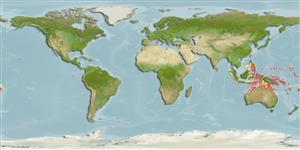Actinopterygii (ray-finned fishes) >
Perciformes (Perch-likes) >
Serranidae (Sea basses: groupers and fairy basslets) > Liopropomatinae
Etymology: Liopropoma: Greek, leio = smooth + Greek, pro = in front of + Greek, poma, -atos = cover, operculum (Ref. 45335). More on author: Randall.
Environment / Climate / Range
Ecology
Marine; reef-associated; depth range 18 - 50 m (Ref. 48635). Tropical, preferred ?; 15°N - 20°S
Western Pacific: Philippines, Palau, Papua New Guinea, the Solomons, Fiji, and Osprey Reef in the Coral Sea; also in Rowley Shoals in the eastern Indian Ocean.
Size / Weight / Age
Maturity: Lm ? range ? - ? cm
Max length : 8.0 cm TL male/unsexed; (Ref. 2334)
Dorsal
spines
(total): 8;
Dorsal
soft rays
(total): 11-12;
Anal
spines: 3;
Anal
soft rays: 8. Easily identified by the unusual coloration. The yellow is obvious but the red looks grey when seen in natural light (Ref. 48635). Differs from L. tonstrinum by having numerous red pinstripes on its sides, a less pronounced white lateral stripe, and a serrate posterior preopercular margin (Ref. 37816).
Generally taken from caves (Ref. 1602). Benthic (Ref. 75154). Rotenone was used for collection (Ref. 1602). Also a ledge dweller, secretive (Ref 90102).
Life cycle and mating behavior
Maturity | Reproduction | Spawning | Eggs | Fecundity | Larvae
Myers, R.F., 1991. Micronesian reef fishes. Second Ed. Coral Graphics, Barrigada, Guam. 298 p. (Ref. 1602)
IUCN Red List Status (Ref. 115185)
CITES (Ref. 94142)
Not Evaluated
Threat to humans
Harmless
Human uses
More information
Common namesSynonymsMetabolismPredatorsEcotoxicologyReproductionMaturitySpawningFecundityEggsEgg development
ReferencesAquacultureAquaculture profileStrainsGeneticsAllele frequenciesHeritabilityDiseasesProcessingMass conversion
Tools
Special reports
Download XML
Internet sources
